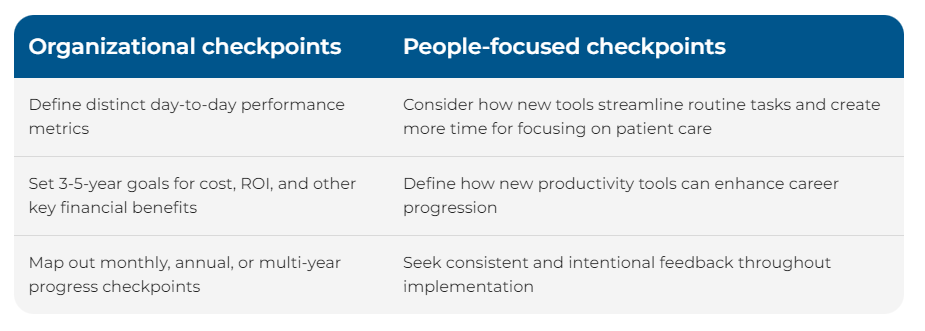In Brief
Creating a culture of enablement through digital transformation in healthcare
- As challenges across cost and talent continue, adopting a people-centric approach to digital transformation is needed to avoid disruptions to productivity and realize ROI for technology investments
- Creating a culture that embraces change aids necessary technology integration and improves how employees work.
- Leaders can enhance culture and technology in tandem by building an actionable roadmap, communicating the "why", and cultivating an organization wide sense of ownership.
Cost pressures, talent shortages, and shifting consumer preferences are forcing healthcare organizations to invest in new technology at a rapid rate. But that level of urgency is also causing significant implementation challenges that stall progress and limit success; Huron’s research shows that three of the top five factors inhibiting ROI relate to people and culture, including lack of user training, cultural aversion to change, and lack of technical staff to drive implementation.
Improvements across data and analytics, patient diagnostics, clinical outcomes, and other business-critical functions make new technology appealing. When executed efficiently, technology integration can reduce administrative inefficiencies and lessen the strain on employees. At the same time, Huron’s research shows that burnout climbed 17% from last year. New tech can result in steep learning curves and potentially existential threats in the form of artificial intelligence (AI) at a time when many workers have already reached their limit.
Rather than accept new technology as an inevitable disruption and cause for further dissatisfaction, savvy organizations are taking a different approach. Three leading practices provide healthcare organizations with the foundation to enhance their culture and technology in tandem.
Build a realistic, actionable road map
Implementing the latest technology for the sake of chasing the newest innovation won’t move the needle. Organizations must not only thoughtfully choose technology that addresses a major pain point or bottleneck, but also consider realistic and trackable objectives to reach before, during, and after implementation.
Including people at all levels throughout the road map process creates a culture of positive change. Integrating staff members and providers early and often, rather than force a disruptive change and expect them to adjust, displays a level of transparency that can help lay the foundation for successful technology implementations.
Balance organizational and people-centric milestones
Leaders can integrate organizational and people-focused elements throughout the road map and ensure cultural milestones, not just ROI and productivity metrics, are part of the conversation.
Articulate the “why”
Senior leaders will no doubt have their eyes on specific metrics and goals throughout implementation – but how do they relay the broader mission to staff members and providers who aren’t as moved by the bottom line?
Leading with empathy is essential here. If people are using new technology on a day-to-day level, they need to be clued into how things are progressing and what kind of impact senior leaders anticipate the technology will have on care delivery, patient outcomes, and community health. Empathy and transparency throughout implementation and post-go-live can pave the way for positive change and create a culture centered around people and technology enablement.
Create an organizational communication plan
A solid communications plan ensures key messages – including success stories, metrics, and pain points – are relayed organization wide. Leaders must focus on delivering the right message at the right time to the right people so that those most impacted can take action. Creating a sense of transparency throughout an organization leads to greater trust across different teams, inspiring staff members and providers to both embrace change and share crucial feedback more readily.
Create an organizationwide sense of ownership
While it’s easy to be enthusiastic about the long-term benefits of new technology – including improved operations and patient outcomes – people are often nervous about potential disruptions throughout implementation and beyond. It’s leadership’s job to diminish that notion and consider how different staff members and providers might be affected by the investment emotionally and how it influences their daily work.
Work to instill an organizationwide sense of ownership and demonstrate how the new technology is a tool to aid productivity and improve workload, rather than an inevitable distraction. To ensure people can hit the ground running, it’s important for leaders to emphasize how crucial their teams are to implementation and educate their people on how to execute.
Implement an organizational readiness network
Successful implementation goes beyond routine upskilling and training. Organizations can empower staff members and providers to own the change from the beginning by setting up an organizationwide readiness network. Functioning as early adopters for the new technology, network members help the project team anticipate future issues, assist colleagues, and serve as communication liaisons to create a positive culture of engagement and people and technology enablement.
If organizations want to create a culture that embraces change and minimizes disruptions throughout implementation, a new approach is crucial. By allowing time for a more thorough planning phase, building out a compelling organizational “why”, and leading with empathy and transparency, they can set themselves up for success and build a culture that not only survives change but thrives within it.

